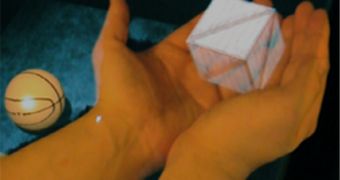HoloDesk is an innovative project from the Sensors and Devices Group, part of the Computer-Mediated Living research area at Microsoft Research.
Steve Clayton, editor at Microsoft, shared the video on October 19, 2011, and some users might already be familiar with this amazing example of exploring of augmented reality.
Softpedia readers will find the video showing the prototype at Microsoft Research Cambridge in action embedded below, and it’s certainly worth the time it takes to watch it, and then maybe even watch it again.
Essentially, the HoloDesk system makes it possible for users to interact with virtual 3D graphics, as the demo clearly shows.
Microsoft’s Rob Knies got in touch with Otmar Hilliges, a researcher in the Sensors and Devices Group, to gain some insight into just how the prototype works.
“We’re using a regular LCD screen to render perspective graphics that are reflected off a semi-silvered mirror,” Hilliges explains.
“The user looks through the semi-silvered mirror so that the scene behind the mirror and the reflected graphics appear combined.”
The semi-opaque surface of the mirror is capable of both reflecting images from the front, as well as letting users view what’s behind it.
In order to get the system to work, HoloDesk relies in the Kinect depth camera to track user motion and make it possible for virtual 3D objects to be manipulated.
“We’ve been trying to simulate human grasping within physics simulations for quite a while,” Hilliges added.
“Previously, the input data weren’t rich enough to allow for the 3-D interaction fidelity that HoloDesk provides. The Kinect is almost perfectly suited for this sort of task, so we started working on this project as soon as it became available to us—a couple of months before public availability.”
The result is physically realistic, palpable interaction between real objects, in this particular case the user’s hands, but also a range of additional items such as pieces of paper, books, a mug, and virtual 3D graphics.
The possibility to directly reach into a 3-D scene [is what makes HoloDesk unique],” Hilliges confesses,“ and to directly touch 3-D objects that respond to this natural user input in a physically plausible manner. Modeling this sort of input was the main contribution of the research around HoloDesk.”

 14 DAY TRIAL //
14 DAY TRIAL //